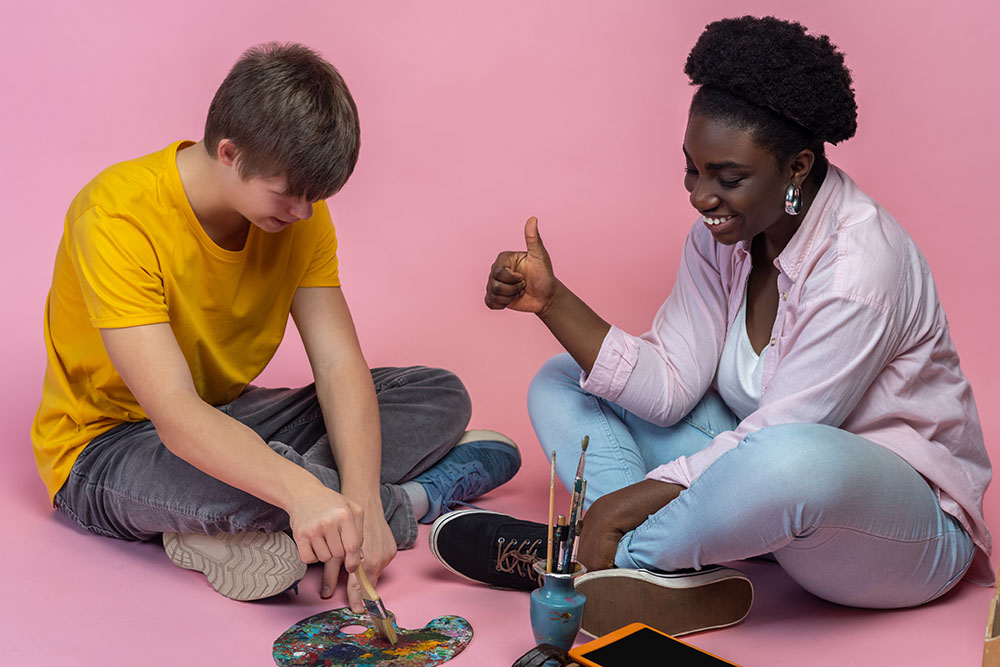
How to Become an Art Therapist: Step-by-Step Guide
Are you passionate about art and eager to help others heal and grow? Imagine combining your love for creativity with a fulfilling career that makes a difference in people’s lives.
Art therapy offers a unique and rewarding path where you can use the power of art to support emotional and psychological well-being. This guide will show you how to become an art therapist, exploring the steps, skills, and qualifications needed to turn your passion into a profession.
As you read on, you’ll discover how this career can transform not only the lives of those you help but also your own. Dive in, and let’s explore the colorful world of art therapy together.
What Is Art Therapy?
Art therapy uses creative processes for healing and self-expression. To become an art therapist, study psychology and art. Gain certification through accredited programs.
Art therapy is a unique form of therapy that uses the creative process of making art to improve mental, emotional, and physical well-being. It allows individuals to express themselves in ways they might not be able to with words alone. Whether you’re an aspiring art therapist or someone curious about this field, understanding what art therapy is can be the first step toward a rewarding journey.
Understanding Art Therapy
Art therapy combines the creative process and psychotherapy to enhance a person’s mental health. It involves using art materials such as paints, clay, and markers to create artwork as a form of expression and communication. This therapeutic approach can help individuals explore their emotions, develop self-awareness, and manage stress. Art therapy offers numerous benefits. It can be a powerful way to process traumatic experiences, reduce anxiety, and increase self-esteem. This form of therapy is not just for those with artistic skills; the focus is on the process, not the final product.
Who Can Benefit From Art Therapy?
Anyone, regardless of age or background, can benefit from art therapy. It’s particularly effective for those who find verbal communication challenging. Children, in particular, often find it easier to express themselves through art. Have you ever felt that words just aren’t enough to convey what you’re feeling? Art therapy might be the outlet you need.
Real-life Example
Consider a teenager struggling with anxiety who finds it hard to talk about their emotions. Through art therapy, they might create a painting that expresses their internal turmoil, allowing them to discuss their feelings with a therapist. This process not only provides relief but also empowers them to take control of their mental health.
How Art Therapy Differs From Traditional Therapy
Unlike traditional talk therapy, art therapy does not rely solely on verbal communication. It provides a safe space to explore thoughts and emotions creatively. This can be particularly beneficial for those who might feel intimidated by the more conventional therapy settings.
What To Expect In An Art Therapy Session
In an art therapy session, you might be asked to create a piece of art based on your feelings or experiences. The therapist will then guide you in discussing your artwork and the emotions it evokes. This process can lead to insights that might not have emerged through words alone. Art therapy is a dynamic field that offers a unique way to heal and grow. Have you considered how creativity can play a role in your mental health journey?

Benefits Of Art Therapy
Discover the path to becoming an art therapist and explore the benefits of art therapy. Art therapy helps express emotions, reduces stress, and improves mental well-being. With creativity, individuals can find healing and personal growth.
Art therapy is more than just painting or drawing; it’s a journey into self-discovery and healing. Many people find solace and relief through art therapy, as it provides a unique way to express emotions that are difficult to put into words. If you’ve ever felt the calming effect of doodling or coloring, you’ve already experienced a small taste of art therapy’s benefits. Let’s delve into how art therapy can positively impact your life.
Improves Emotional Well-being
Art therapy allows you to express feelings in a safe environment. Whether you’re feeling sad, angry, or stressed, creating art helps you to release these emotions. Over time, this process can improve your overall emotional health.
Enhances Self-awareness
When you create art, you often uncover feelings and thoughts you weren’t consciously aware of. This newfound insight can be transformative. It encourages you to reflect on your experiences and understand yourself better.
Boosts Self-esteem
Creating art can give you a sense of accomplishment. When you complete a piece, no matter how small, you gain confidence in your abilities. This confidence can extend into other areas of your life, improving your overall self-esteem.
Facilitates Stress Relief
Art therapy is an excellent way to unwind. When you’re focused on creating, your mind has a chance to rest from worries. The act of creating can be meditative, reducing stress and promoting relaxation.
Encourages Personal Growth
Through art, you explore new perspectives and ideas. You challenge your boundaries and grow as a person. This process of self-exploration can lead to significant personal development.
Fosters Social Connections
Joining a group art therapy session can connect you with others who share similar experiences. Sharing your art and stories creates bonds and a sense of community. This support network can be invaluable during challenging times.
How Can You Start?
Consider enrolling in an art therapy course to learn the basics. Seek a certified art therapist for guidance. Remember, you don’t need to be an artist to benefit; it’s about the process, not the product. Have you tried art as a form of therapy? What was your experience like? Would you be willing to give it a try? Share your thoughts in the comments below!
Educational Requirements
To become an art therapist, earn a bachelor’s degree in psychology or art. A master’s degree in art therapy is also required. Courses often include psychology, counseling, and studio art.
Embarking on a journey to become an art therapist is both exciting and fulfilling. But before you can start helping others through the healing power of art, you need to meet certain educational requirements. Understanding what degrees and courses are needed will set you on the right path. Let’s dive into what you need to know to turn your passion for art and helping others into a rewarding career.
Degrees Needed
To become an art therapist, you typically need a master’s degree in art therapy or a related field. This advanced degree equips you with the necessary skills and knowledge to practice professionally. Some programs might offer a dual-degree option, combining art therapy with mental health counseling or social work. This allows you to broaden your expertise and increase your job prospects. Consider programs accredited by the American Art Therapy Association (AATA), which ensure that you receive quality education aligned with industry standards.
Recommended Courses
Courses in psychology are essential. They provide a foundation in understanding human behavior, which is crucial when working with clients. Art-specific courses, such as painting, sculpture, and drawing, enhance your creative skills and enable you to guide others effectively. Courses in therapy techniques, such as counseling methods and group therapy dynamics, prepare you for real-world scenarios where you apply art as a therapeutic tool. Have you ever thought about how the blend of art and psychology can impact lives? These courses not only prepare you academically but also challenge your perspective on healing and creativity. Whether you’re drawn to the vibrant colors of a canvas or the intricate patterns of human thought, these educational steps are your gateway to making a difference through art therapy.
Certification And Licensing
Embarking on the journey to become an art therapist involves understanding the certification and licensing process. These credentials not only validate your expertise but also empower you to make a difference in the lives of those seeking therapeutic healing through art. Let’s dive into the essentials of certification and licensing, ensuring you’re prepared to take the next steps towards your dream career.
Certification Bodies
Certification bodies are your first stop in acquiring official recognition as an art therapist. These organizations set the standards for professional practice and ensure that therapists are well-equipped to provide effective care.
One prominent body is the Art Therapy Credentials Board (ATCB). They offer the Registered Art Therapist (ATR) credential, which is highly valued in the field.
To earn this certification, you need a combination of education and supervised experience. You might wonder, what if I don’t have a background in art or therapy? You can start from scratch with a master’s degree in art therapy, which includes both art and psychology courses.
Licensing Process
The licensing process varies depending on where you live, but it generally involves meeting state-specific requirements. This might include passing a comprehensive exam and accumulating supervised clinical hours.
Many states require you to hold the ATR credential before you can apply for a license. This ensures you have the foundational skills needed to practice independently.
Imagine completing your supervised hours and feeling ready to take on your first solo client. Licensing is the final step that officially grants you the ability to practice as a certified professional in your state.
Have you considered how acquiring certification and licensing could transform your career path? These steps not only elevate your professional status but also open doors to various opportunities in mental health settings, schools, and private practices.
Approach this journey with curiosity and dedication. Your unique experiences and perspectives will enrich the field of art therapy. What impact do you hope to make in the lives of others through this transformative practice?
Skills And Qualities
Becoming an art therapist involves more than just a love for art. It requires a unique blend of skills and qualities. These abilities help art therapists connect with clients and support their healing journey. Let’s dive into the key skills and qualities essential for a successful career in art therapy.
Creative Skills
Art therapists need strong creative skills. They use various art forms to help clients express themselves. Creativity allows therapists to tailor activities to each client’s needs. This skill also helps in developing new techniques for therapy sessions. A good grasp of different art mediums is beneficial.
Interpersonal Skills
Effective communication is crucial in art therapy. Therapists must listen actively and respond appropriately. Good interpersonal skills help in building trust with clients. This trust is vital for clients to open up and share their feelings. Strong communication also aids in explaining therapeutic processes clearly.
Empathy And Understanding
Empathy is a core quality for art therapists. They must understand clients’ emotions without judgment. Empathy helps in providing a safe space for expression. Understanding different backgrounds and experiences is crucial. This quality fosters a supportive environment for healing and growth.
Gaining Experience
Becoming an art therapist involves more than just academic learning. Real-world experience is crucial. Engaging with diverse communities enhances your skills. It builds confidence. This practical knowledge is gained through internships and volunteer work. These opportunities offer invaluable insights into the field. They prepare you for a rewarding career.
Internships
Internships provide hands-on experience in art therapy. Many institutions offer structured programs. These programs immerse you in real-world settings. You work alongside experienced professionals. This mentorship is invaluable. It helps you understand therapy techniques. You learn to interact with clients effectively. Internships often lead to job offers. They open doors to career advancement. Seek internships in hospitals and mental health centers. These environments offer diverse learning experiences.
Volunteer Opportunities
Volunteering is another way to gain experience. It allows you to practice art therapy skills. Community centers often need volunteers. They offer a chance to work with varied groups. This diversity enriches your learning. Schools also welcome volunteers for art therapy programs. Volunteering builds your professional network. It enhances your resume. It shows commitment to the field. Look for opportunities in local organizations. They often need passionate individuals.
Finding A Job In Art Therapy
Finding a job in art therapy involves creativity and dedication. This field blends psychology and the arts to help individuals express themselves. Art therapists work in schools, hospitals, and private practices. But securing a position can be challenging. Strategic planning and networking are key. Let’s explore effective methods for landing your dream role.
Job Search Tips
Research potential employers thoroughly. Understand their mission and values. Tailor your resume to highlight relevant skills and experiences. Use keywords from job descriptions. This boosts your visibility to employers. Prepare a portfolio showcasing your work. Display your understanding of art therapy techniques. Practice your interview skills. Be ready to discuss case studies or past projects. This demonstrates your ability to apply art therapy effectively.
Networking Strategies
Attend art therapy conferences and workshops. Connect with industry professionals. Join online forums and groups. Participate in discussions to expand your knowledge. Reach out to alumni from your program. They may offer valuable advice or job leads. Volunteer at community centers or art events. This increases your experience and visibility. Build relationships with other therapists. They can provide insights and recommend opportunities.
Continuing Education
Continuing education is a crucial step for anyone looking to become a proficient art therapist. It’s not just about getting your initial certification or degree; it’s about constantly learning and growing within your field. This ongoing education ensures you stay updated with the latest methods and techniques, which ultimately improves your effectiveness as a therapist.
Advanced Training
Advanced training can make a significant difference in your career as an art therapist. This training often includes specialized courses that dive deeper into specific areas of art therapy, such as trauma-informed practices or working with children. These courses not only expand your knowledge but also enhance your ability to cater to diverse client needs.
Imagine being able to help a child express emotions through art after taking a course on pediatric art therapy. Such advanced skills can make you an invaluable resource for your clients. Have you considered which area of art therapy you’d like to specialize in?
Workshops And Seminars
Attending workshops and seminars is another excellent way to continue your education. These events are often packed with valuable information, offering you the chance to learn directly from experts in the field. They also provide a fantastic opportunity for networking, allowing you to connect with fellow art therapists.
I once attended a weekend seminar on mindfulness and art therapy, and it completely transformed my approach. The hands-on activities and collaborative discussions opened my eyes to new techniques I hadn’t considered before. What kind of workshops could enhance your skills and inspire new ideas?
Continuing education isn’t just about gaining new knowledge; it’s about enriching your practice and staying passionate about your work. By investing in advanced training and participating in workshops and seminars, you ensure that your skills are always evolving. This proactive approach not only benefits you but also the clients you serve. What steps will you take to further your education in art therapy?
Challenges In Art Therapy
Art therapy offers healing through creativity. It comes with its own set of challenges. Understanding these challenges can help aspiring therapists navigate their career path.
Emotional Demands
Art therapists often deal with intense emotions. Clients may express deep pain through art. This requires therapists to be emotionally strong. They must handle distressing situations calmly. Seeing clients’ struggles can be overwhelming. Therapists need self-care practices. This helps them stay balanced and effective.
Professional Boundaries
Maintaining boundaries is crucial in art therapy. Therapists must separate personal feelings from professional duties. They must respect clients’ privacy and autonomy. Sometimes, clients may push limits. It’s essential to enforce clear boundaries. This ensures a safe and trusting environment. Protecting professional space avoids burnout.


Frequently Asked Questions
What Is Art Therapy?
Art therapy is a mental health profession. It uses creative processes to improve emotional well-being. This therapy helps individuals express themselves non-verbally. Through art, people can explore emotions and reduce stress. Art therapy can be used for personal growth and healing.
How Do I Become An Art Therapist?
To become an art therapist, earn a master’s degree in art therapy. Accredited programs provide necessary training. Gain clinical experience through supervised internships. After graduation, obtain certification or licensure. Requirements vary by region. Continuing education is crucial for career advancement.
What Skills Are Needed For Art Therapy?
Art therapists need strong communication skills. Empathy and patience are essential. Creativity and artistic knowledge are important. Understanding psychological theories and therapeutic techniques is crucial. Being able to work with diverse populations is beneficial.
Can Art Therapy Help With Anxiety?
Yes, art therapy can help reduce anxiety. It provides a safe space to express feelings. Creating art can be calming and meditative. It helps individuals process emotions and develop coping strategies. Art therapy can improve mental health and enhance emotional resilience.
Conclusion
Becoming an art therapist is a rewarding and fulfilling career. It combines creativity and helping others. Start with understanding the field deeply. Pursue relevant education and certifications. These steps are crucial. Practical experience is vital too. It helps build confidence and skills.
Networking with professionals can open doors. Always keep learning and growing. Passion and dedication make a difference. As you progress, remember the impact of your work. Helping others heal through art is powerful. Embrace the journey and enjoy each step.
Your passion for art and helping others will guide you.





